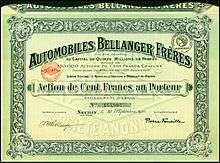Bellanger (automobile)
|
| |
| Industry | Automotive |
|---|---|
| Fate | acquired by (initially) Peugeot |
| Founded | 1912 |
| Founder | The Bellanger brothers |
| Defunct | 1925 |
| Headquarters | Neuilly-sur-Seine, France |
| Products | Cars |
Société des Automobiles Bellanger Frères was a French automobile manufacturer between 1912 and 1925.[1] The cars were the brainchild of Robert Bellinger (1884-1966), who had previously sold Delaunay-Belleville vehicles.[1]
History of the business

Robert Bellanger and his brothers founded the business in 1912 for the production of motor cars. The company was situated at Neuilly-sur-Seine on the north-western edge of Paris, in the Rue de la Révolte, today a section of the subsequently renamed Boulevard Pershing in the 17th arrondissement of Paris.[2]
The cars were branded “Bellanger” although badges carrying the longer name “Bellanger Frères” (Bellanger Brothers) was also sometimes featured on the car badges. The Bellanger slogan was "Son capot est d'argent et son silence est d'or" - "her bonnet is silver and her silence is golden".[1]
Robert Bellanger embarked in a career as a politician in the 1920s and the "Bellanger Frères" business was sold in 1925, one of several smaller French automakers acquired by Peugeot around this time. However, in 1928 the site was sold again, and became the property of the newly formed Automobiles L. Rosengart business and used for the production under license of the little Austin 7.
Bellanger had also started to produce aero-engines during the First World War. Despite disposing of the automotive business, Bellanger continued to produce aero-engines till 1928.[3]
The cars
The first cars, introduced a couple of years before the First World War, were powered by sleeve valve Daimler engines of 2000 cm³, 2600 cm³, 3000 cm³ and 6300 cm³. The first three of these were frequently used for taxi work in Paris.
During the war the manufacturer concentrated on supplying the military.
After the war car production resumed in 1919, starting with the A1, powered by a 3.2 litre 4 cylinder side valve engine.[1] The A1 was designed by Valentin Laviolette, who had previously designed cars for Spyker. Bellanger had by now switched to Briscoe Frères as its engine supplier.[4]
The manufacturer took at stand at the 15th Paris Motor Show in October 1919, and exhibited what had by now become its postwar three car model range:[4]
- "Bellanger Type A1", 4-cylinder 3,170 cc (17 HP): Wheelbase 2,800 mm (110.2 in)
- "Bellanger Type D", 4-cylinder 4,240 cc (30 HP): Wheelbase 3,750 mm (147.6 in)
- "Bellanger Type F", V8-cylinder 6,340 cc (50 HP) ohv: Wheelbase 3,750 mm (147.6 in)
The "Type F" was presented as the star of the show stand and was priced by the manufacturer accordingly at 60,000 francs in bare chassis form.[4]
In 1928, three years after the Bellangers had sold their factory, De Dion-Bouton manufactured some of their Model JP cars with vee-radiators, and marketed them under the name "Bellanger Model B1", but this venture lasted less than a year.
External links
| Wikimedia Commons has media related to Bellanger. |
- Bellanger logo
- Restored 1921 A1 sedan
- GTÜ Gesellschaft für Technische Überwachung mbH (abgerufen am 9. März 2013)
References
- 1 2 3 4 Georgano, Nick (2000). The Beaulieu Encyclopedia of the Automobile. London: Stationery Office. p. 1792. ISBN 0117023191.
- ↑ This part of Neuilly lay along the line of the city's old fortifications, and was incorporated into Paris in 1929. The Bellanger factory must therefore have been sited directly beside the position of the modern Palais des congrès, at Porte Maillot (Paris Métro).
- ↑ http://exhumoir.kazeo.com/les-exhumations/automobiles-bellanger-france,a748303.html
- 1 2 3 "Automobilia". Toutes les voitures françaises 1920 (salon [Oct] 1919). Paris: Histoire & collections. Nr. 31: 62. 2004.